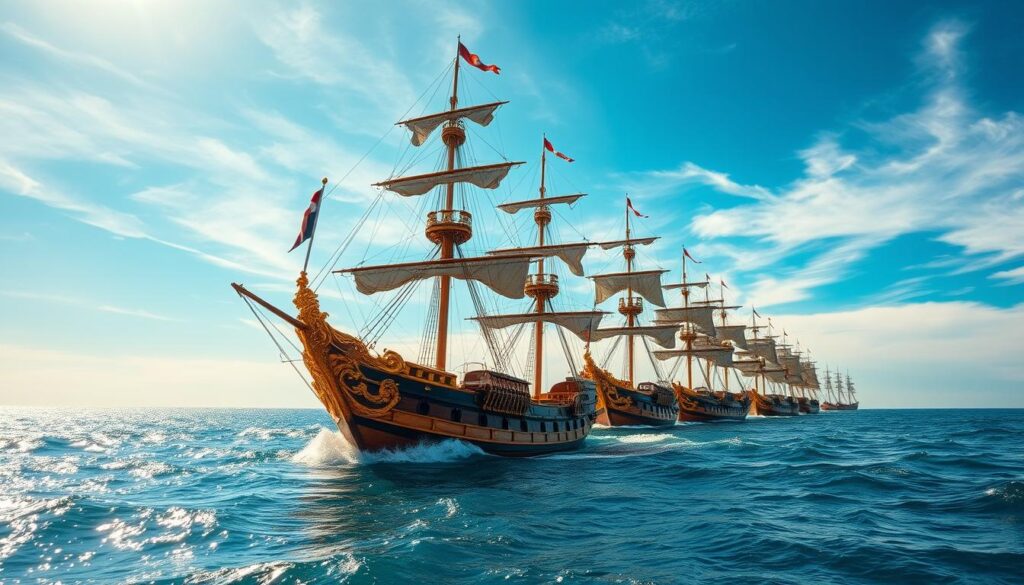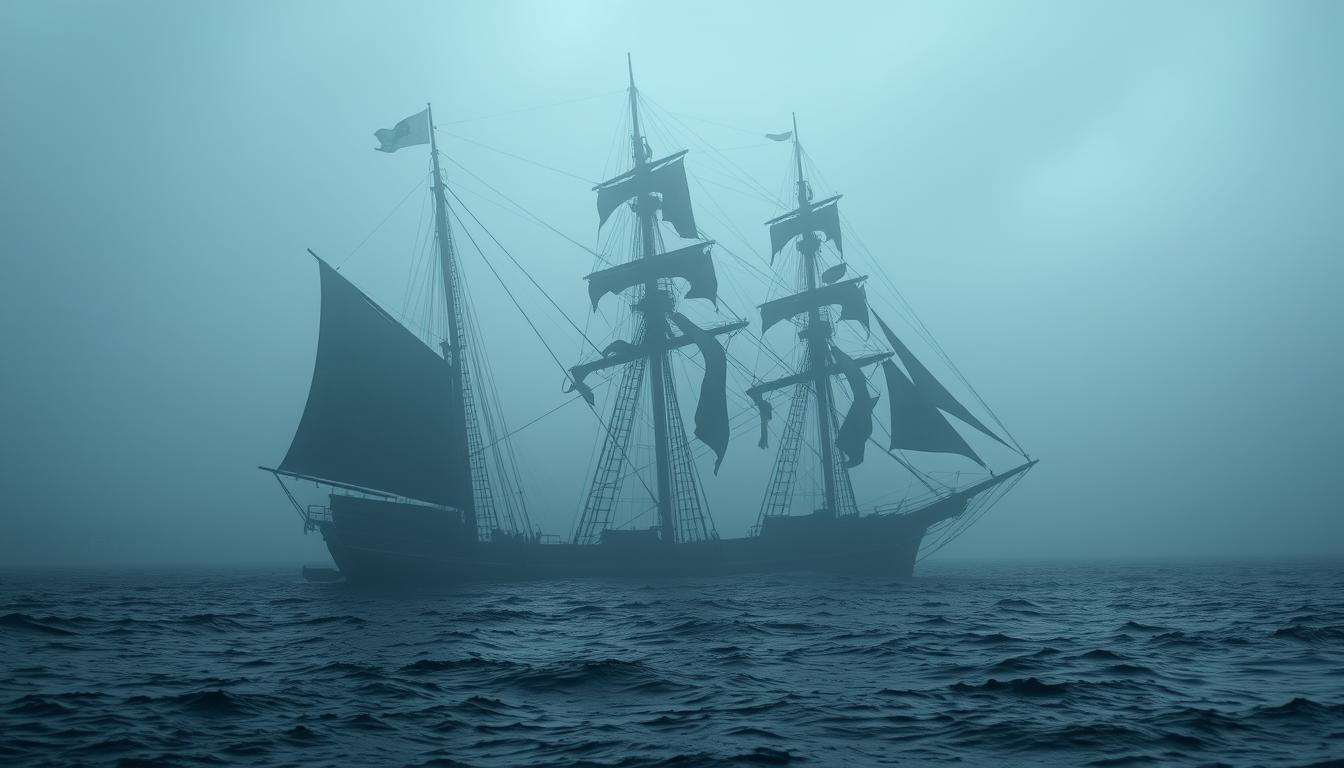I set out to separate story from fact along a busy maritime stretch where sea and coast shaped sailors’ imaginations. In this article I trace how a single haunting name took hold in local lore and then spread around the world.
My goal is clear: I compare firsthand accounts, archives, and recorded tragedies to weigh what is credible and what feeds the mystery.
I describe ships seen in fog, a notorious 19th‑century disaster, and how treasure tales often attach themselves to dramatic coastlines. I write in the first person so you can follow my reasoning step by step.
By blending history with eyewitness reports, I aim to give readers a grounded, helpful narrative that respects maritime tradition while testing sensational claims.
Key Takeaways
- I separate folklore from documented events around Cádiz waters.
- Reports combine sailor experience, tragic loss, and a long-lived mystery.
- Treasure narratives often cloud historical fact and deserve careful review.
- Firsthand accounts and archives form the factual backbone I use.
- The story remains compelling because the name echoes maritime history.
How I set the scene: Cádiz waters, sailors’ lore, and a sea where mystery still sails
I frame the Bay of Cádiz as a threshold where currents and weather made routine voyages feel uncertain and memorable. A lone lantern after a long sail or a distant hull could gain a name before anyone checked its papers.
I listened to sailors at dockside and on watch. Their oral tradition kept small reports alive across days and years. A seasoned crew would pass on a caution that worked like a map: remember the shoals, delay the sail when fog thickened.
“We told the story to keep men careful; a sighting was often a warning, not a miracle.”
Local festivals and processions kept maritime life centered on the coast. That cultural focus let stories travel with captains and pilots along trade routes. Over time, ships and a single ship took on personalities, and one apparition became a shared memory.
| Cause | What they saw | Practical meaning |
|---|---|---|
| Fog & light | Distant lanterns or hull | Delay departure |
| Currents & sandbars | Strange surf or glow | Plot safer course |
| Oral reports | Repeated sightings | Community memory |
My aim here is to show how practical seamanship and superstition blended so a ghost at sea also worked as a shorthand for risk.
Legend of the Ghost Ship of Cádiz
On misty nights I heard a recurring account: a tattered galleon sliding just beyond the breakers, its rigging vanishing in and out of fog. That image carried a practical edge; it was less a proof than a pattern that sailors used to read weather and danger.
What I’ve heard in the fog: a spectral galleon on the Bay
I collected versions where a pale hull seemed to blink into view miles offshore. Witnesses described a shape that looked like an old ship, then dissolved as light and swell shifted.
Why captains treated the sight as an omen
Those who watched took it seriously: a sudden barometer fall or a change in swell often followed. Shortening sail after such a sight is a simple choice that has, by many accounts, saved a crew from a wreck.
How this story crossed coasts and years
The power of the legend rests on repetition. Different ships, different dates, similar silhouettes—this repeatable pattern kept the mystery alive and let treasure whispers attach themselves to an already cautious tradition.
“A warning at sea can wear many faces; stories teach us to watch.”
When history haunts the coast: the Reina Regente and a real tragedy in the Strait
I map the final hours of a Spanish cruiser that set sail from Tangier on 9 March 1895 and was last reported battling a violent storm near Cabo Espartel.
Witnesses on the English steamers Mayfield and Matheus put the vessel about 12 miles northwest of the cape, rolling heavily yet still making way. Hours later she vanished with roughly 412 people aboard.
The technical facts matter: the protected cruiser measured 95.5 meters, had a 15.25 m beam, displaced about 4,800 tons, and produced 12,000 horsepower. That power made her a notable ship in world naval history.
Theories include sudden capsizing from synchronized pitching, flooding after a seam failure, or mechanical loss that left the captain and crew helpless. No bodies or definitive wreck were recovered in the days and years that followed.
| Observed fact | Leading theory | Evidence |
|---|---|---|
| Last sighting 12 miles NW of Cabo Espartel | Synchronized pitching → sudden foundering | Eyewitness reports; no wreck site |
| 412 (≈415–420) aboard | Rapid capsizing after flooding | No bodies recovered; official loss declared |
| Powerful cruiser (1895 design) | Rudder/engine failure in heavy seas | Ship plans exist; mechanical failure unproven |
| Other ships lost same storm | Extraordinary weather | Contemporary reports; Carpio lost that day |
“Without wreck evidence, grief and stories filled the gap between fact and finality.”
From treasure fleets to shipwrecks: Spain’s seafaring past that fuels today’s ghost stories
I follow how early exploration and imperial convoys turned coastal waters into magnet points for treasure tales. Columbus’s 1492 voyage and Ponce de León’s 1513 expedition set routes that linked two worlds and filled holds with gold and silver. That flow created a shipping system built around protection and timing.

Age of exploration foundations
I trace how these expeditions made Spain the center of a global fleet. Convoys met in Havana, then set sail back spain under escort to shield bullion from storms and privateers.
Armadas, galleons, and famous losses
The Armada’s 1588 disaster and galleon sinkings left deep marks on naval history. The San José, lost in 1708 near Cartagena and announced found in 2015, symbolizes how a single wreck can anchor decades of treasure lore.
Myth-making at the edge of fact
Captains and crews mixed seamanship with tradition. Over time, shipwrecks and recoveries fed discovery fever and fictional claims—like an online hoax about a Nuestra Señora cache—that borrow real practice to seem true.
“When a route carried wealth, a story often followed—so ask which year and which fleet before you believe a claim.”
Conclusion
I close by weighing what hard records show against what coastal custom has kept alive. I separate clear evidence from the cultural tradition that gave a name to a recurring sight and to a local legend.
Respect for the people lost in each tragedy matters. I note how a ghost ship sighting still warned a crew to delay a risky sail on a bad day and how that caution helped at sea today.
The Reina Regente and other vessels form the sober part of this history. Treat any catchy claim in an article as a start, not a conclusion; seek logs, weather data, and archaeology before you spread a story into the wider world.


Lascia un commento